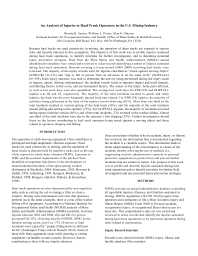Mining Publication: An Analysis of Injuries to Haul Truck Operators in the U.S. Mining Industry
Original creation date: September 2010
Because haul trucks are used extensively in mining, the operators of these trucks are exposed to various risks and hazards inherent to this occupation. The objective of this work was to profile injuries sustained during haul truck operations, to identify priorities for further investigation, and to determine potential injury prevention strategies. Data from the Mine Safety and Health Administration (MSHA) annual administrative database were sorted and reviewed to select records identifying a subset of injuries sustained during haul truck operations. Records covering a 5-year period (2004-2008) involving haul trucks were reviewed. The majority of the injury records were for injuries classified as "struck against moving object" (STRUCK) (N=613) and "slip or fall of person from an elevation or on the same level" (SLIPFALL) (N=359). Each injury narrative was read to determine the activity being performed during the injury (such as ingress, egress, driving, maintenance), the incident results (such as operator impact and truck impact), contributing factors to the event, and environmental factors. The nature of the injury, body parts affected, as well as lost work days were also quantified. The average lost work days for STRUCK and SLIPFALL injuries was 60 and 62, respectively. The majority of the total incidents resulted in sprain and strain injuries; the back was the most frequently injured body part injured. For STRUCK injuries, the majority of activities being performed at the time of the injuries involved driving (63%). More than one-third of the total incidents resulted in vertical jarring of the haul truck (36%), and the majority of the total incidents caused jolting and jarring to the operator (75%). For SLIPFALL injuries, the majority of incidents occurred during egress from the vehicle (46%), and of the total incidents, 32% resulted in the worker falling. Almost one-third of the total incidents were due to the operator’s foot slipping (32%). Further investigation should focus on the factors contributing to haul truck operators being struck against a moving object and those related to operators slipping and falling.
Authors: BR Santos, WL Porter, AG Mayton
Conference Paper - September 2010
Proceedings of the Human Factors and Ergonomics Society 54th Annual Meeting, September 27-October 1, 2010, San Francisco, California. Santa Monica, CA: Human Factors and Ergonomics Society, 2010 Sep; 54:1870-1874
See Also
- Acceleration and GPS Data Monitor Truck-Haulage Jolts
- An Analysis of Serious Injuries to Dozer Operators in the U.S. Mining Industry
- Characteristics of Fugitive Dust Generated from Unpaved Mine Haulage Roads
- Mining Haul Truck Cab Noise: An Evaluation of Three Acoustical Environments
- Monitoring Blind Spots: A Major Concern for Haul Trucks
- The Potential Impact of Light Emitting Diode Lighting on Reducing Mining Injuries During Operation and Maintenance of Lighting Systems
- Recommendations for Evaluating & Implementing Proximity Warning Systems on Surface Mining Equipment
- Surface Haulage Truck Research
- Test Results of Collision Warning Systems for Surface Mining Dump Trucks
- Tying Acceleration and GPS Location Information Together To Create a Mine Management Tool
- Page last reviewed: 9/21/2012
- Page last updated: 9/21/2012
- Content source: National Institute for Occupational Safety and Health, Mining Program


 ShareCompartir
ShareCompartir
